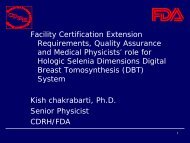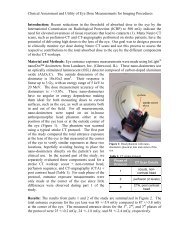SBRT Treatment Planning: Practical Considerations
SBRT Treatment Planning: Practical Considerations
SBRT Treatment Planning: Practical Considerations
You also want an ePaper? Increase the reach of your titles
YUMPU automatically turns print PDFs into web optimized ePapers that Google loves.
<strong>SBRT</strong> <strong>Treatment</strong> <strong>Planning</strong>:<br />
<strong>Practical</strong> <strong>Considerations</strong><br />
Linda Hong, Ph.D.<br />
Montefiore Medical Center<br />
Albert Einstein College of Medicine<br />
Bronx, New York
I have no conflicts of interest to disclose.
Outlines<br />
• The Basic Principles of <strong>SBRT</strong> <strong>Treatment</strong> <strong>Planning</strong><br />
Conventional fractionated plan vs. <strong>SBRT</strong> plan<br />
Cranial SRS plan vs. <strong>SBRT</strong> plan<br />
• <strong>Practical</strong> <strong>Considerations</strong> on <strong>SBRT</strong> <strong>Treatment</strong> <strong>Planning</strong><br />
Spine<br />
Lung<br />
Liver<br />
• Lessons learned from our experiences
Stereotactic Body Radiation Therapy<br />
(<strong>SBRT</strong>)<br />
• Fractional dose >5Gy<br />
range: 5 Gy to 34 Gy per fraction<br />
• Number of fractions
Montefiore-Einstein <strong>SBRT</strong> Experiences<br />
• Started 1 st <strong>SBRT</strong> Spine 1/2008<br />
• Started 1 st <strong>SBRT</strong> Lung 4/2008<br />
• Started 1 st <strong>SBRT</strong> Liver 8/2008<br />
• About 2 new <strong>SBRT</strong> cases weekly ever<br />
since<br />
• Machines Varian Trilogy or Truebeam<br />
• Eclipse TPS
Montefiore-Einstein Cancer Center (MECC) <strong>SBRT</strong> Registry<br />
Spine<br />
1-3 lesions<br />
• Single Fraction: 16 Gy<br />
• Three Fraction: 24 Gy (8 Gy per fraction)<br />
Lung<br />
Peripheral Lesions<br />
• Three fractions: 60 Gy (20 Gy per fraction)<br />
Central Lesions<br />
• Five fractions: 50 Gy (10 Gy per fraction)<br />
Liver<br />
Metastasis<br />
• If lesions > 2cm from Porta Hepatis/Bile Duct: Three Fractions 20Gy x 3<br />
• If lesions ≤ 2cm from Porta Hepatis/Bile Duct: Five Fractions 10Gy x 5<br />
Hepatocellular Carcinoma<br />
• Five fractions: 30-50 Gy (depends on Veff)
RTOG <strong>SBRT</strong> Protocols<br />
• 0631 Spine<br />
• 0813 and 0915 Lung<br />
• 0438 Liver<br />
These protocols specify detailed<br />
requirements for treatment planning:<br />
Dose Prescription<br />
Target Coverage<br />
Dose Constraints
The Basics of <strong>Treatment</strong> <strong>Planning</strong> for <strong>SBRT</strong><br />
• The goal of <strong>SBRT</strong> treatment is to “ablate” tissues within<br />
the PTV, these tissues were not considered at risk for<br />
complications.<br />
Dose inhomogeneity inside the PTV was considered<br />
acceptable (potentially advantageous) and not<br />
considered a priority in plan design.<br />
Maximum point dose up to 160% of Prescription Dose is<br />
common for <strong>SBRT</strong> plans.<br />
• The main objective of the plan is to minimize the volume<br />
of those normal tissues outside PTV receiving high dose<br />
per fraction.
If beam margin is close to beam penumbra (5-6 mm)→<br />
Homogeneous PTV dose, Maximum dose about 110% of Prescription Dose<br />
(PD).<br />
Dose fall off outside PTV is slow<br />
PTV<br />
PTV<br />
Beam Margin<br />
Beam Margin<br />
PTV<br />
If beam margin is much less than beam penumbra (0-2 mm) →<br />
Inhomogeneous PTV dose, Maximum dose ~ 125% or more of PD.<br />
Dose fall off outside PTV is fast<br />
PTV
FIG. 1. Homogeneity index (Ratio of<br />
Maximum PTV Dose to the PD) vs.<br />
beam margin.<br />
Cranial SRS <strong>Planning</strong><br />
FIG. 3. a Conformity index (Ratio of PD<br />
Volume to PTV Volume) vs. homogeneity<br />
index.<br />
Hong et al.: LINAC-based SRS: Inhomogeneity, conformity, and dose<br />
fall off, Med. Phys., Vol. 38, No. 3, March 2011
For single isocenter dose<br />
distributions, the dose fall-off<br />
from prescription isodose to<br />
half of the prescription dose<br />
typically occurs over the<br />
shortest distance if the dose<br />
is prescribed to the 80%<br />
isodose shell, with 100% as<br />
maximum dose.<br />
If 100% is PD, then 125%<br />
should be the maximum dose<br />
to have sharpest ratio of<br />
R 50% (Ratio of 50%<br />
Prescription isodose volume<br />
to the PTV volume)<br />
Sanford L. Meeks et al Int. J. Radia. Onc. Biol. Phys., Vol. 41, No. 1, pp. 183–197, 1998
Normal Tissue Volume receiving<br />
50% of PD increases sharply as<br />
PTV inhomogeneity decreases<br />
below 120% of PD<br />
Hong et al.: LINAC-based SRS: Inhomogeneity, conformity, and dose fall<br />
off, Med. Phys., Vol. 38, No. 3, March 2011
Conventional <strong>SBRT</strong><br />
(Ablative intent)<br />
PD per fraction 3Gy or less 5 Gy or more<br />
# of fractions 10 or more 5 or less<br />
Dose Distribution Homogeneous<br />
(maximum PTV dose ~<br />
110%)<br />
Dose Gradient outside<br />
PTV<br />
Heterogeneous<br />
(maximum PTV dose up<br />
to 160%)<br />
Shallow slope Steep slope
20Gy x 3 plan is different from 2Gy x 30 plan<br />
a small lung lesion example (PTV volume 33cc)<br />
<strong>SBRT</strong> Conventional<br />
# of Beams 11 11 3<br />
Beam Margin (mm) 1 5 5<br />
PD per fraction 20 Gy 2 Gy 2 Gy<br />
Max PTV Dose (%) 124.2% 110.8% 110.0%<br />
V 100% 38.6 cc 44.3 cc<br />
(5.7 cc more)<br />
V 50% (R 50%) 146.3 cc (4.4) 212.4 cc (6.4)<br />
(66cc more)<br />
V 25% 630.4 cc 799.2 cc<br />
(169 cc more)<br />
50% PD 10 Gy 1 Gy 1 Gy<br />
87.5 cc<br />
(48.9 cc more)<br />
417.3 cc (12.6)<br />
(271 cc more)<br />
756.8 cc<br />
(126 cc more)<br />
All Plans normalized to PTV V100% = 95%
For <strong>SBRT</strong> plans<br />
Prescription Isodose level is usually not 100% PD covering 100% PTV<br />
Often 95% PD covering 95% PTV or higher<br />
Or 100% PD covering 95% PTV or higher<br />
This coverage was chosen because of the increased tissue volumes that<br />
must be irradiated to cover the corners of the PTV on each consecutive<br />
CT slice if 100% coverage is required.<br />
For conventional plans<br />
Often 100% PD dose to 100% PTV
<strong>SBRT</strong> planning principles are very similar to<br />
Cranial SRS planning principles<br />
• Inhomogeneous Dose inside PTV<br />
• Sharp Dose Fall Off outside PTV<br />
• Multiple non-coplanar beams or arcs are<br />
needed to create conformal dose<br />
distributions.<br />
Much more limited non-coplanar beam<br />
clearance compared with cranial SRS for<br />
LINAC based <strong>SBRT</strong>.
Requirements of <strong>SBRT</strong> Plan<br />
(from RTOG 0813 and 0915 lung protocols)<br />
• Maximum Dose: normalized to 100%, must be within PTV<br />
• Prescription Isodose: must be ≥ 60% and < 90% of the maximum<br />
dose<br />
• Prescription Isodose Surface Coverage: 95% of the target<br />
volume (PTV) is conformally covered by the prescription isodose<br />
surface (PTV V100%PD = 95%) and 99% of the target volume<br />
(PTV) receives a minimum of 90% of the prescription dose (PTV<br />
V90%PD > 99%)<br />
• High Dose Spillage: The cumulative volume of all tissue outside the<br />
PTV receiving a dose > 105% of prescription dose should be no<br />
more than 15% of the PTV volume<br />
• Intermediate Dose Spillage: The falloff gradient beyond the PTV<br />
extending into normal tissue structures must be rapid in all directions<br />
and meet the criteria in Table1<br />
• Meet the constraints of dose limiting organs at risk
RTOG 0813 (lung) and RTOG 0915 (lung) Table1
The published protocols usually do not<br />
specify R 50% or D 2cm requirements for spine<br />
and liver cases. Nevertheless, we find lung<br />
protocol criteria useful for spine and liver<br />
cases as well.
RTOG 0631 (Spine)<br />
Definition of Spine Metastasis Target Volume<br />
Figure 2: Diagram of Spine Metastasis and Target Volume<br />
An epidural lesion is included in the target volume provided<br />
that there is a ≥ 3 mm gap between the spinal cord and the edge of the<br />
epidural lesion.
10cm<br />
Conventional Cord<br />
10cm<br />
RTOG 0631 (Spine)<br />
Max point dose
Montefiore-Einstein Cancer Center<br />
<strong>SBRT</strong> Registry Study<br />
Spine<br />
1-3 lesions<br />
• Single Fraction: 16 Gy (RTOG 0631)<br />
(for cases we have confidence in setup, for example: inferior T-spine<br />
and L-spine lesions)<br />
• Three Fraction: 24 Gy (8 Gy per fraction)<br />
(for cases with setup uncertainty large, for example: C-spine and<br />
superior T-spine lesions)
For Spine Cases:<br />
IMRT or VMAT is required to create concave dose<br />
distributions.<br />
We use two full RapidArcs, or two partial RapidArcs to avoid<br />
shoulders or arms, one arc with collimator at 0, the other with<br />
collimator at 90.<br />
Multiple fixed IMRT fields can be used.<br />
No need to do any non-coplanar beams (no clearance<br />
anyway).
Maximum Dose: must be within PTV<br />
Prescription Isodose: If PD = 100%, maximum dose must be at least 111.11%<br />
but not more than 166.67%<br />
Prescription Isodose Surface Coverage:<br />
95% of the target volume (PTV) is conformally covered by the prescription<br />
isodose surface (PTV V100% = 95%)<br />
and<br />
We follow RTOG 0813 and RTOG 0915 lung protocols<br />
criteria for PTV coverage, high dose spillage and dose<br />
fall off<br />
99% of the target volume (PTV) receives a minimum of 90% of the prescription<br />
dose (PTV V90% > 99%)
Cord: Max point dose 9.33 Gy<br />
V100% = 95%<br />
V90% > 99%
PTV<br />
2cm-3cm ring<br />
Prescription Isodose Surface Coverage:<br />
PD = 100% = 16 Gy<br />
PTV V100 = 95%<br />
PTV V100 = 95%<br />
100% PD and Above<br />
Cor<br />
CAX<br />
Sag
Prescription Isodose Surface Coverage:<br />
PD = 100% = 16 Gy<br />
PTV V90% > 99%<br />
Here PTV V90% = 100%<br />
90% PD and Above<br />
COR<br />
CAX<br />
SAG
High Dose Spillage:<br />
PD = 100% = 16 Gy<br />
Max PTV dose = 135.3%<br />
105% covered volumes<br />
outside of PTV
Conformality : Prescription Dose Volume vs. PTV Volume<br />
PD = 100% = 16 Gy<br />
V100 / PTV volume
Intermediate Dose Spillage: R 50% and D 2cm<br />
For PTV = 19.1 cc<br />
R 50% < 4.6; D 2cm = 52.7%<br />
Here V50% = 77.0 cc<br />
R 50% = 4.0<br />
D 2cm = 43.6%<br />
50% PD and Above<br />
COR<br />
R50% : Ratio of 50% PD volume/PTV volume<br />
D2cm : Maximum dose in % of PD at 2cm<br />
beyond PTV in any direction<br />
CAX<br />
SAG
COR<br />
CAX<br />
SAG<br />
No need to do any<br />
non-coplanar beams<br />
(no clearance<br />
anyway).<br />
25% PD and Above
12.5% PD and Above<br />
Cor<br />
CAX<br />
16Gy x 12.5% = 2Gy<br />
SAG
Single Arc Collimator 45<br />
CAX<br />
Two Arcs: Collimator 0 and 90<br />
CAX<br />
COR<br />
100% PD and Above<br />
COR<br />
PTV 2cm-3cm ring<br />
SAG<br />
SAG
Single Arc Collimator 45<br />
CAX<br />
Two Arcs: Collimator 0 and 90 50% PD and Above<br />
CAX<br />
COR<br />
COR<br />
PTV 2cm-3cm ring<br />
SAG<br />
SAG
Additional 15 cc volume of normal tissue receiving 5% PD<br />
Single Arc Collimator 45<br />
CAX<br />
CAX<br />
Two Arcs: Collimator 0 and 90<br />
COR<br />
5% PD and Above<br />
COR<br />
PTV 2cm-3cm ring<br />
SAG<br />
SAG
Coll 45<br />
Coll 0<br />
Jaw opening area twice as much<br />
When compared to collimator<br />
At 0 or 90.<br />
More leakage dose in<br />
Superior and inferior beyond PTV.<br />
Leaves parked inside jaws when<br />
Unused for RapidArc<br />
Coll 90
Fixed IMRT Fields<br />
100% PD and above 50% PD and above<br />
25% PD and above 12.5% PD and above<br />
11 fixed field IMRT<br />
Can meet similar<br />
R 50% and D 2cm<br />
constraints
COR<br />
Fixed IMRT Fields: 7-9 posterior beams<br />
9 Field IMRT<br />
50% PD and Above<br />
SAG<br />
CAX<br />
Sometimes difficult to meet<br />
R50% and D2cm constraints if<br />
you use those constraints.<br />
Cord:<br />
Sometimes difficult to meet 10Gy<br />
constraints, even though max<br />
point dose 14Gy can be met.
9 Field IMRT: Cord Dose DVH<br />
10 Gy 0.99cc<br />
10 Gy 11.9%<br />
RTOG 0631 Criteria:<br />
10 Gy covers
Montefiore-Einstein Cancer Center<br />
<strong>SBRT</strong> Registry Study<br />
Lung<br />
Peripheral Lesions<br />
• Three fractions: 60 Gy (20 Gy per fraction) (Based on RTOG 0618)<br />
Central Lesions<br />
• Five fractions: 50 Gy (10 Gy per fraction) (Based on RTOG 0813)<br />
For Lung cases, it is often necessary to have non-coplanar<br />
beams to achieve fast dose fall off.<br />
We use three partial arc VMAT technique<br />
Each arc at least 100 degree<br />
Non-coplanar couch angle up to 20 degree<br />
Non-coplanar multiple IMRT or 3DCRT beams can be also<br />
used.
Arc2: Couch 15, Gantry 330-110<br />
Arc1: Couch 0, Gantry 179-30<br />
Arc3: Couch 345, Gantry 110-330<br />
Arc 2 and Arc 3 are mostly anterior arcs to gain clearance
MECC <strong>SBRT</strong> Registry: Lung<br />
Constraints<br />
Three Fraction (20Gy x 3) (Based on dose of RTOG 0618):<br />
Heart: Maximal point dose is 30 Gy (10 Gy per fraction)<br />
Ipsilateral brachial plexus: Maximal point dose is 24 Gy (8 Gy per fraction)<br />
Spinal Cord: Maximal point dose is 18 Gy (6 Gy per fraction)<br />
Esophagus: Maximal point dose is 27 Gy (9 Gy per fraction).<br />
Trachea/ipsilateral bronchus: Maximal point dose is 30 Gy (10 Gy per<br />
fraction)<br />
Whole lung minus GTV: V20
Prescription Isodose Surface Coverage:<br />
PD = 100% = 20 Gy/fx x 3<br />
PTV V100 = 95%<br />
PTV V100 = 95%<br />
100% PD and Above<br />
Cor<br />
CAX<br />
Sag
Prescription Isodose Surface Coverage:<br />
PD = 100% = 20 Gy/fx x 3<br />
PTV V90% > 99%<br />
Here PTV V90% = 100%<br />
90% PD and Above<br />
CAX<br />
COR SAG
High Dose Spillage<br />
PD = 100% = 20 Gy/fx x 3<br />
Max PTV dose = 135.0%<br />
105% covered volumes<br />
outside of PTV
Conformality : Prescription Dose Volume vs. PTV Volume<br />
PD = 100% = 20 Gy/fx x 3<br />
V100 / PTV volume
Intermediate Dose Spillage: R 50% and D 2cm<br />
For PTV = 40.2 cc<br />
R 50%
25% isodose restricted<br />
mainly in the ipsilateral lung<br />
25% PD and Above
12.5% isodose restricted<br />
mainly in the ipsilateral lung<br />
12.5% PD and Above
MECC <strong>SBRT</strong> Registry: Lung<br />
Constraints<br />
Five Fraction(10Gy x 5) Based on RTOG 0813:<br />
Heart:
Liver<br />
Montefiore-Einstein Cancer Center<br />
<strong>SBRT</strong> Registry Study<br />
Metastasis<br />
If lesions > 2cm from Porta Hepatis/Bile Duct: Three Fractions 20Gy x 3<br />
If lesions ≤ 2cm from Porta Hepatis/Bile Duct: Five Fractions 10Gy x 5<br />
HCC<br />
• Five fractions: 30-50 Gy (depends on V eff)<br />
• V eff Dose per fraction<br />
< 0.3 10 Gy x 5<br />
0.3 - 0.4 9 Gy x 5<br />
0.4 - 0.5 8 Gy x 5<br />
0.5 - 0.6 6 Gy x 5<br />
Dawson LA et al Acta Oncol 45:856, 2006<br />
Same beam arrangements/techniques can be used as lung <strong>SBRT</strong>.
MECC <strong>SBRT</strong> Registry: Liver<br />
Constraints<br />
Metastasis<br />
If lesions > 2cm from Porta Hepatis/Bile Duct: Three Fractions 20Gy x 3<br />
If lesions ≤ 2cm from Porta Hepatis/Bile Duct: Five Fractions 10Gy x 5<br />
Liver minus-GTV: >700mL receive
Hepatocellular Carcinoma<br />
Five Fractions<br />
MECC <strong>SBRT</strong> Registry: Liver<br />
Constraints
Stereotactic body radiation therapy:<br />
The report of AAPM Task Group 101<br />
Stanley H. Benedict et al<br />
Med. Phys. 37 (8), August 2010<br />
Detailed information about <strong>SBRT</strong>
<strong>SBRT</strong> CT simulation<br />
• For upper thoracic regions, both arms (elbows)<br />
should be over the patient’s head and included<br />
in the CT scan so that clearance of beams can<br />
be visualized during planning.<br />
• Scan 15 cm beyond field borders (sometimes<br />
non-coplanar beams are needed).<br />
• For spine cases, include sacrum for lower spine<br />
or include C1 for upper spine so that vertebrae<br />
can be easily identified.
<strong>SBRT</strong> C-Spine<br />
• CT scan has to include C1<br />
• Setup uncertainty large due to flexibility in neck<br />
area<br />
• Fusion with MRI might be difficult because of<br />
different neck position<br />
• 2-3mm margin should be added for PTV<br />
• Hypofractionation preferred instead of single<br />
fraction – unless significant cord clearance<br />
• We use BlueBAG TM with vacuum suction plus<br />
head and neck mask as immobilization device
<strong>SBRT</strong> T-Spine<br />
• CT scan has to either include C1 or L<br />
Spine<br />
• Arms on the side preferred so that patient<br />
can stay comfortable<br />
• Beams avoid arms<br />
• We use BlueBAGTM with vacuum suction<br />
as immobilization device
<strong>SBRT</strong> L-Spine<br />
• CT has to include Sacrum<br />
• Arms on chest instead of up for comfort<br />
• We use BlueBAG TM with vacuum suction<br />
as immobilization device
<strong>SBRT</strong> Lung/Liver/Abdominal Cases<br />
• 4DCT simulation must be done first to access tumor<br />
motion range<br />
• Gating will be considered only if motion > 0.5cm, and the<br />
patient has a regular, reproducible breathing pattern;<br />
alternatively, an ITV can be created.<br />
• For gating cases, BlueBAG TM without vacuum suction is<br />
used as immobilization device.<br />
• Abdominal Belt Compression system can be used for<br />
some patients<br />
• Fiducials necessary for Liver/Abdominal Cases: no other<br />
way to visualize tumor. CBCT image quality, FOV<br />
limitation for lateral tumors.<br />
• If no fiducials for Lung cases, Fluoro on the machine<br />
must be done before simulation to verify visualization of<br />
tumor
<strong>SBRT</strong> Lung/Liver/Abdominal Cases<br />
• If non-gating, may consider one or both arms on<br />
the side. Non-coplanar beams could be used to<br />
compensate for lateral beams. If gating is used,<br />
only coplanar beams can be used for some<br />
machines, arms on the side could further limits<br />
beams.<br />
• VMAT is a good option (can not be combined<br />
with gating for many machines)<br />
• Gating + fixed beam IMRT or EDW is not<br />
advisable (takes way too long to deliver), use<br />
FIF instead if you must.<br />
• Beam arrangement should consider collision<br />
possibility for lateral tumors. Keep beams /arcs<br />
on the ipsilateral side.
<strong>SBRT</strong> Lung/Liver/Abdominal Cases<br />
• If no fiducials, create fluoro beam aperture that<br />
hugs GTV.<br />
• If there is fiducials, create fluoro beam aperture<br />
that use fiducials as corners.<br />
• CBCT alignment with GTV, bony landmark<br />
secondary but should be less than 1cm<br />
discrepancy. Otherwise, reposition patient.<br />
• CBCT sometimes do not align well with average<br />
sim CT due to breathing variation<br />
• Fluoro to verify positioning after CBCT.<br />
• Fluoro between fields to monitor setup<br />
consistency.
Under fluoro: only the MLC shape outline (hugs GTV) will be visible on screen<br />
When the shape turns green, beam is on.<br />
GTV is visible on screen when fluoro is on.<br />
Our goal is to for GTV to match MLC shape when beam is on.
GTV is 5mm too inferior<br />
(MLC acts as a scale).<br />
CBCT was done with<br />
free breathing (non-gated),<br />
therapist did not align<br />
superior part of CBCT<br />
with Gated CTsim tumor<br />
during image fusion.<br />
After 5mm superior shift.<br />
At one different angle<br />
During treatment (a<br />
Total of 3 was done<br />
during treatment).
Bottom line for <strong>SBRT</strong><br />
• Without an approved plan in the patient’s<br />
chart, no treatment verification can be<br />
done. Physics must be present for<br />
treatment verification.<br />
• If IMRT, without IMRT QA documented, no<br />
1 st treatment should be done.<br />
• Attending must be present for every<br />
treatment fraction. Physics should be<br />
available for every treatment.
What is a ‘Dry Run’?<br />
• <strong>Treatment</strong> verification<br />
– Reproduce setup<br />
– Verify isocenter<br />
– Clinically mode up each treatment field<br />
Check beam clearance (collision)<br />
Check any interlock<br />
MLC interlock? Reinitialized but can not clear means<br />
corruption of MLC files undeliverable beam<br />
Potential MU problem? For example > 1000 for any<br />
single field beyond machine capability for non-SRS<br />
beams<br />
Clearly mark immobilization devices after successful dry run.
Summary<br />
• RTOG protocols are useful guidelines for<br />
treatment planning for <strong>SBRT</strong><br />
• <strong>SBRT</strong> procedures from CT simulation to<br />
treatment planning to treatment verification<br />
and treatment warrant serious attention<br />
from everyone involved. Establishing clear<br />
protocols for your own institution is<br />
necessary for the safe delivery of <strong>SBRT</strong>.
Acknowledgements<br />
• Physics<br />
Jin Shen<br />
Joe Lee<br />
Aleiya Gafa<br />
Paola Godoy-Scripes<br />
Jack Kessel<br />
Dinesh Mynampati<br />
Kuo, Hsiang-Chi<br />
Ravindra Yaparpalvi<br />
Wolfgang Tome<br />
• Physicians<br />
William Bodner<br />
Madhur Garg<br />
Jana Fox<br />
Maury Rosenstein<br />
Keyur Mehta<br />
Chandan Guha<br />
Shalom Kalnicki
Thank You


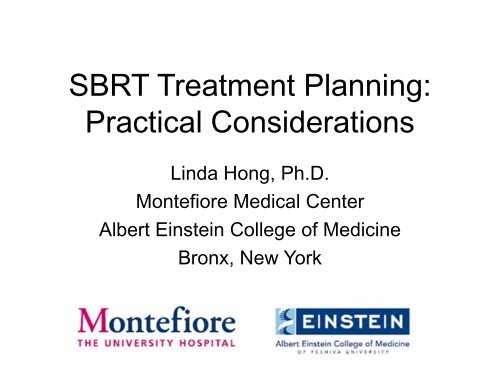






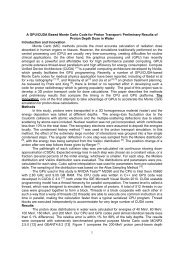
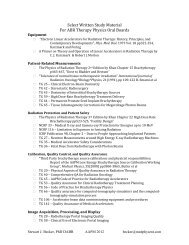

![SBRT&StereoscopicIGRT_2012 [Compatibility Mode]](https://img.yumpu.com/16889220/1/184x260/sbrtstereoscopicigrt-2012-compatibility-mode.jpg?quality=85)


